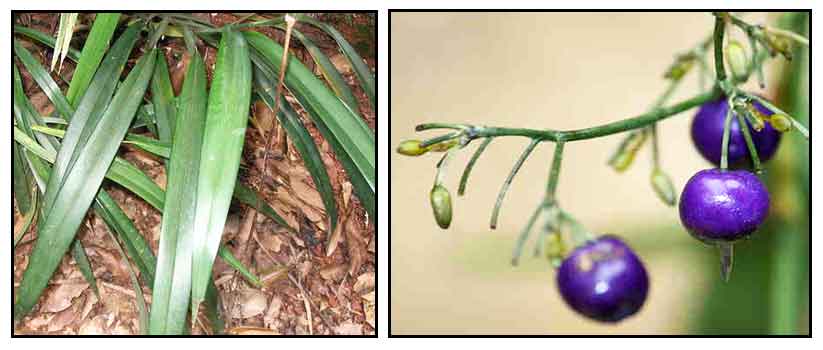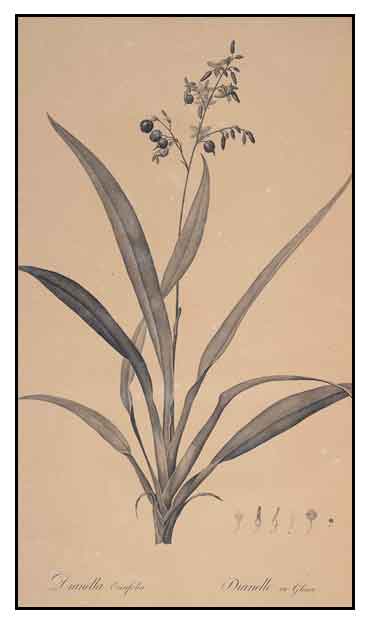 Etymology Etymology
Species name derives from Latin: Diana, the Roman Sylvan goddess, ella meaning small stature, and ensifolia referring to the sword shaped leaves.
Botany
Sword leaf dianella is a perennial with stems 60 to 150 centimeters long. Leaves are grass-like, linear-lanceolate, 30 to 60 centimeters long, and 2 to 4 centimeters wide, growing from a branched and spreading rhizome. Inflorescence is 30 to 60 centimeters long. Flowers are white greenish or bluish, with the segments 6 to 8 millimeters long, and reflexed. Berries are ovoid and bluish.
 Distribution Distribution
- In light forests at low altitudes in Palawan, Panay, Jolo, Bucas Grande and Mindanao.
- Also occurs in India to the Mascarene Islands, in China, Taiwan, Malaya, in tropical Australia and in Polynesia.
Constituents
- Benzenoids: Musizin (dianellidin), methyl 2,4-dihydroxt-3,5,6-trimethylbenzoate, methyl 2.4-dihydroxy-3,6-dimethylbenzoate, methyl 2,4-dihydroxy-6-methylbenzoate (methyl orsellinate), 2,4-dihydroxy-6-methoxy-3-methylacetophenone.
- Leaves yielded armandinol, a new dihydronaphtaquinone 2-hexyl-3-(2-hydroxyethyl)-2,3-dihydronaphtaquinone 1-4, together with two known quinones, chrysophanol (2) and isoeugenitol (3). (8)
- Study of roots
isolated two new favans, (2S)-2',4'-dihydroxy-7-methoxy-8-methylflavan (1) and (2S)-2'-hydroxy-4',7-dimethoxy-8-methylflavan (2). (see study below) (11)
- Study of roots isolated a new cycloartane-type triterpenoid, named 22-hydroxy-cyclolaudenol (1), together with two known cycloartane-type triterpenoids. (see study below) (12)
Properties
- Hard roots have a characteristic smell.
- Vermifuge, vulnerary, tonic.
- Studies suggest antioxidant, anti-inflammatory, antibacterial, tyrosinase inhibitory, anticancer properties.
Parts used
Rhizomes, roots, leaves.
Uses
Folkloric
-
Poultices of roots applied to the abdomen as vermifuge.
- Used for dysentery.
- Roots used as postpartum tonic.
Also used for leucorrhea and dysuria.
- Ashes of roots and leaves are ingredients in an ointment for herpes.
- Leaves used for poulticing wounds.
- In China, paste of plant applied to swellings.
-
In Cambodia, Laos, and Vietnam, plant used for fatigue. In Indonesia, used for gastrointestinal infections, herpes, urogenital disorders, and skin infections.
(5)
- In southern Thailand, roots used for kidney diseases. Preparations from whole plant used to relieve paralysis.
- In Indonesia, dried roots are chewed for deworming.
- Poultice of roots applied externally to the abdomen as vermifuge.
- Ashes of roots and leaves applied as ointment to treat boils, itches, herpetic sores and rheumatism.
- In Thailand, roots used for kidney diseases.
- Dry powdered rhizomes blended with vinegar applied locally for furunculosis and abscesses, lymphangitis, tuberculous lymphadenitis, tinea and traumatic injuries.
- In Malaysia, roots mixed with resin of Styrax and used as incense in healing and other rituals. (13)
- In Madagascar, roots used for abdominal pain. (14)
Cosmetics
- Skin pigmentation: An ingredient in skin cream preparations as antioxidant and to reduce hyperpigmentation. Also used in skin whitening preparations.
Others
- Poison: Reported use of roots as rat poison.
- Fumigant: Roots used for fumigation.
- Ceremonial Incense: Used as incense in Torajanese funeral ceremonies in South Central Celebes.
Poison concerns
-
Roots reportedly used as rat poison.
- Berries regard as poisonous, with reported symptoms of dizziness, hiccups, and difficulty breathing. (No studies found on toxicity or poisoning.(
Studies
• Chemical Constituents / Roots: Study of roots yielded musizin (dianellidin), methyl 2,4-dihydroxt-3,5,6-trimethylbenzoate, methyl 2.4-dihydroxy-3,6-dimethylbenzoate, methyl 2,4-dihydroxy-6-methylbenzoate (methyl orsellinate), 2,4-dihydroxy-6-methoxy-3-methylacetophenone. (1)
• Antioxidant / Skin Discoloration Modification: Skin pigmentation has been linked to free radicals, and free radical scavengers and antioxidants can slow pigmentation. D. ensifolia extracts yielded 1-(2,4-dihydrophenyl)-3-(2,4-dimethoxy-3-methylphenyl) propane (DP), which was found to inhibited free radicals DPPH. Cosmetic formula containing DP produced an increase rate of pigmentation fading compared to two pharmaceuticals containing 4% hydroquinone (HQ). (3)
• Anti-Inflammatory / Antibacterial: Study has shown anti-inflammatory and analgesic activities.
• UP302 / Natural Antioxidant: Study isolated novel natural antioxidant, UP302, from Dianella ensifolia. (4)
• Tyrosinase Inhibitor / UP302a and UP302b: Study of the whole reported a large-scale isolation of 1-(3-Methyl-2,4-dimethoxyphenyl)-3-(2′,4′-dihydroxyphenyl)-propane (UP302a) and 1-(3-methyl-2,4-dimethoxyphenyl)-3-(2′,5′-dihydroxyphenyl)-propane (UP302a). UP302a showed more with potent tyrosinase inhibition at 57%.
• Flavans / Cytotoxic Effects Against Cancer Cell Lines / Roots: Study of roots isolated two new favans, (2S)-2',4'-dihydroxy-7-methoxy-8-methylflavan (1) and (2S)-2'-hydroxy-4',7-dimethoxy-8-methylflavan (2). Compounds 1 ands 2 exhibited cytotoxic effects against cancer cell lines MDA--MB-231, B16-F10, HCT116, and A549. (11)
•
Triterpenoid / Cytotoxic Against Cancer Lines / Roots: Study of roots isolated a new cycloartane-type triterpenoid, named 22-hydroxy-cyclolaudenol (1), together with two known cycloartane-type triterpenoids. Compound 1 showed cytotoxicity against cancer cell lines B16-F10, A549, and MDA-MB-231. (see constituents above) (12)
Availability
- Wild-crafted.
- Ingredient in skin care products for acne, skin lightening.
|

![]()



 Etymology
Etymology Distribution
Distribution